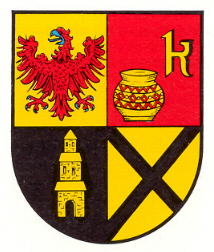Kleinsteinhausen: Difference between revisions
Jump to navigation
Jump to search
Knorrepoes (talk | contribs) m (Text replacement - "/Arms of " to "/Arms (crest) of ") |
Knorrepoes (talk | contribs) m (Text replacement - "{{media}}" to " {{de1}} {{media1}}") |
||
| Line 24: | Line 24: | ||
The eagle and cross are taken from the arms of the medieval Lords of Ettendorf, who ruled the villages of Gross- and Kleinsteinhausen. The second quarter shows an urn for the many Celtic artifact that have been found in the village, as well as the letter K for the village. The third quarter shows a canting stone house (Steinhaus) and refers to the Stainhäuser family from the village. | The eagle and cross are taken from the arms of the medieval Lords of Ettendorf, who ruled the villages of Gross- and Kleinsteinhausen. The second quarter shows an urn for the many Celtic artifact that have been found in the village, as well as the letter K for the village. The third quarter shows a canting stone house (Steinhaus) and refers to the Stainhäuser family from the village. | ||
{{ | |||
{{de1}} | |||
{{media1}} | |||
[[Civic Heraldry Literature - Germany|'''Literature''']]: Debus, 1988 | [[Civic Heraldry Literature - Germany|'''Literature''']]: Debus, 1988 | ||
Revision as of 11:34, 26 December 2022
This page is part of the German heraldry portal |
Heraldry of the World |
|
German heraldry:
|
Selected collector's items from Germany:
|
KLEINSTEINHAUSEN
State : Rheinland-Pfalz
District (Kreis) : Südwestpfalz
Verbandsgemeinde : Zweibrücken-Land
Origin/meaning
The arms were granted on June 17, 1982.
The eagle and cross are taken from the arms of the medieval Lords of Ettendorf, who ruled the villages of Gross- and Kleinsteinhausen. The second quarter shows an urn for the many Celtic artifact that have been found in the village, as well as the letter K for the village. The third quarter shows a canting stone house (Steinhaus) and refers to the Stainhäuser family from the village.
Literature: Debus, 1988


